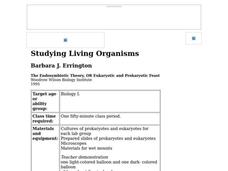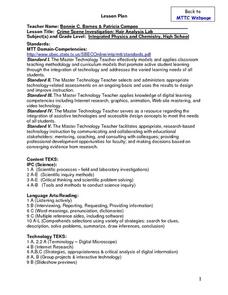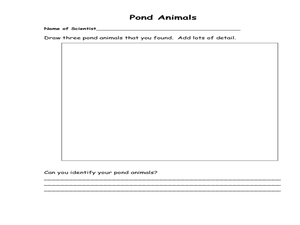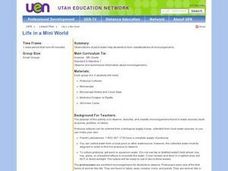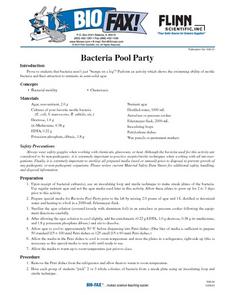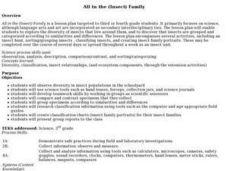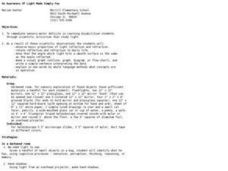Curated OER
What Is an Egg Without its Shell?
Learners observe osmosis, a cellular process that normally can't be observed without a microscope, and use scientific method to observe osmosis in a chicken egg.
Curated OER
Studying Living Organisms
Students are introduced to Hardy-Weinberg Equilibrium without recourse to algebra. After participating in this activity, students gain a feeling for the significance of the Hardy-Weinberg Equilibrium without using algebra.
Curated OER
Let's Learn About Lettuce
Students learn more about lettuce. In this agriculture lesson, students listen to their instructor lecture about the history of lettuce. Students then participate in an activity that requires them to compare and contrast iceberg lettuce...
Curated OER
The Internal Anatomy of the Grasshopper
Sixth graders explore the internal organs of grasshoppers. They determine the function of the organs through a dissection activity.
Curated OER
Muscles
In this muscles worksheet, students describe characteristics of the three types of muscle and the function of each. Then they describe the gross and microscopic anatomy of skeletal muscle. Students also describe the steps that occur in a...
Curated OER
The Hidden World
Students examine dust mites and other allergens. In this dust lesson students complete a lab activity on dust mites.
Curated OER
Does the increased use of fertilizers effect biodiversity?
Pupils conduct a hands-on lab activity in which they analyze a sample of water from a local stream or pond. They introduce a fertilizer solution into the sample and analyze and describe their findings.
Curated OER
Crime Scene Investigation: Hair Analysis Lab
Students participate in a hair analysis lab. Using a digital microscope, students compare and contrast hair samples. They determine if the hair samples are human or animal. After completing lab results sheets, students share their...
Curated OER
It's a Small World After All! (Pond Microcosms)
Students use microscopes to investigate the diversity of life that exists in pond water. They then conduct a controlled investigation to study the effect of a pollutant (rice) on a microcosm ecosystem.
Curated OER
Pond and Pond Organisms
Students explore pond ecosystems. In this pond organism activity, students will use pond water and a plastic bad in order to locate and identify freshwater organisms. The activity is designed for younger grades, but...
Curated OER
Life in a Mini World
Sixth graders observe, describe, and classify microorganisms found in water sources. In small groups, they make their own slide, observe the Protozoa under a microscope, and record and classify the microorganisms.
Curated OER
Using A Winogradsky Column to Analyze Microbial Communities
Students use easily obtained materials to study ecological succession in a microbiological community. This investigation is appropriate for a variety of age groups. Elementary Students be fascinated by the changes occurring over time...
Curated OER
Scientific Notation
Learners explore the concept of expressing numbers in scientific notation. In this scientific notation instructional activity, students understand the importance of using scientific notation by finding real world examples where...
Biology Junction
Bacteria Crossword Puzzle
In this biology instructional activity, students complete a crossword puzzle with 42 questions about bacteria. They identify the different characteristics of bacteria.
Curated OER
Sea Connections: Marine Ecosystems
Learners identify producers and consumers from marine ecosystems and describe the balance among them in the environments. After constructing a food chain from a marine ecosystem, they examine human activities that can upset the balance...
Curated OER
Bacteria Pool Party
Students investigate the organisms of bacteria. They are given a culture of bacteria that can be observed under a microscope. The students make observations that are recorded. The lesson includes the mention of specific safety...
Curated OER
All in the (Insect) Family
Students participate in a series of activities in order to explore the diversity of insects. They explore how insects are grouped and categorized.
Curated OER
The Chemistry of Hair Care
Students do hands-on activities and read information online in order to answer the central question of this lesson: How does understanding the chemistry of hair care, including the role of pH, help in the development of better hair-care...
Curated OER
Animals: Worms
Students research the physical characteristics of mealworms and tubefex. In this worm lesson, students explore worms using a microscope. Students search their environment for worms.
Curated OER
Species Diversity and Phylogeny
Students explore the classification system of organisms: taxonomy. They examine prepared slides of Protozoans and record information on a Taxonomy Recording Sheet. Two additional classifying activities are also included in this lesson.
Curated OER
The Lunar Disk
Students analyze lunar material using actual moon rocks that were brought back by Apollo astronauts. The teacher and student activity sheets are well-designed.
Curated OER
Science: Suddenly Snow
Students engage in snow-related activities during the first winter snowfall. After explaining the elements needed for it to snow, they preserve snowflakes on frozen slides and observe them under a microscope. Then, they write diamante...
Curated OER
An Awareness of Light Made Simply Fun
Learners with sensory perception issues discover the properties of light through a series of excellent hands on activities. They look at beams of lights in a darkened room; use a kaleidoscope and optical illusions as they experience the...
Curated OER
The Science of Forensics
Students examine the importance of details in evidence gathering, as well as the relationship between chemistry, physics and biology. In this forensics lesson students divide into groups and look at fingerprints and fill out an...

